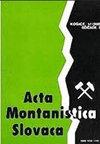利用浸入式水口传热数学模型防止堵塞
IF 1.4
4区 地球科学
Q2 GEOSCIENCES, MULTIDISCIPLINARY
引用次数: 0
摘要
钢在水下入口喷嘴(SEN)中的堵塞主要是由于钢与SEN耐火材料的结块和/或相互作用。然而,连续铸钢也会导致堵塞——在铸造开始时钢在SEN中冻结。钢在SEN中凝固的主要原因是几何形状的改变、钢的铸造温度低、SEN预热不足和初铸速度低。为了消除连铸初期钢的冻结问题,作者采用SEN内传热的数学模型对其进行了求解。利用该数学模型,可以模拟SEN内的温度分布和钢的界面- SEN内表面的温度分布,确定中间包安装后SEN内的温度分布。采用自由对流法测量加热后SEN平均温度的下降。在数学模型模拟分析当前状态的基础上,可以确定当壁厚或隔离厚度发生变化时防止钢在SEN中冻结的条件。本文章由计算机程序翻译,如有差异,请以英文原文为准。
Prevent of clogging via a mathematical model of heat transfer in submerged entry nozzle
Clogging of the steel in the submerged entry nozzle (SEN) is mainly due to the agglomeration and/or interaction of the steel with the SEN refractory material. However, the continuous casting steel also leads to clogging - the freezing of the steel in the SEN at the beginning of the casting. The freezing of the steel in the SEN results mainly in the change in the geometry, the low casting temperature of steel, the insufficient preheating of the SEN and the low initial casting speed. To eliminate the problems of steel freezing at the beginning of continuous casting, the authors solved them using a mathematical model of heat transfer in the SEN. Using the mathematical model, it is possible to simulate the layout of temperatures in the SEN and the temperature of the steel at the interface of steel - the inner surface of the SEN. To determine the temperature layout in the SEN after installation on the tundish, a method of measuring the decreased average temperatures of the SEN by free convection after heating was used. Based on the analysis of the current state using simulations in a mathematical model, it is possible to define conditions for preventing the freezing of steel in the SEN when the wall thickness or isolation thickness is changing.
求助全文
通过发布文献求助,成功后即可免费获取论文全文。
去求助
来源期刊

Acta Montanistica Slovaca
地学-地球科学综合
CiteScore
3.60
自引率
12.50%
发文量
60
审稿时长
30 weeks
期刊介绍:
Acta Montanistica Slovaca publishes high quality articles on basic and applied research in the following fields:
geology and geological survey;
mining;
Earth resources;
underground engineering and geotechnics;
mining mechanization, mining transport, deep hole drilling;
ecotechnology and mineralurgy;
process control, automation and applied informatics in raw materials extraction, utilization and processing;
other similar fields.
Acta Montanistica Slovaca is the only scientific journal of this kind in Central, Eastern and South Eastern Europe.
The submitted manuscripts should contribute significantly to the international literature, even if the focus can be regional. Manuscripts should cite the extant and relevant international literature, should clearly state what the wider contribution is (e.g. a novel discovery, application of a new technique or methodology, application of an existing methodology to a new problem), and should discuss the importance of the work in the international context.
 求助内容:
求助内容: 应助结果提醒方式:
应助结果提醒方式:


